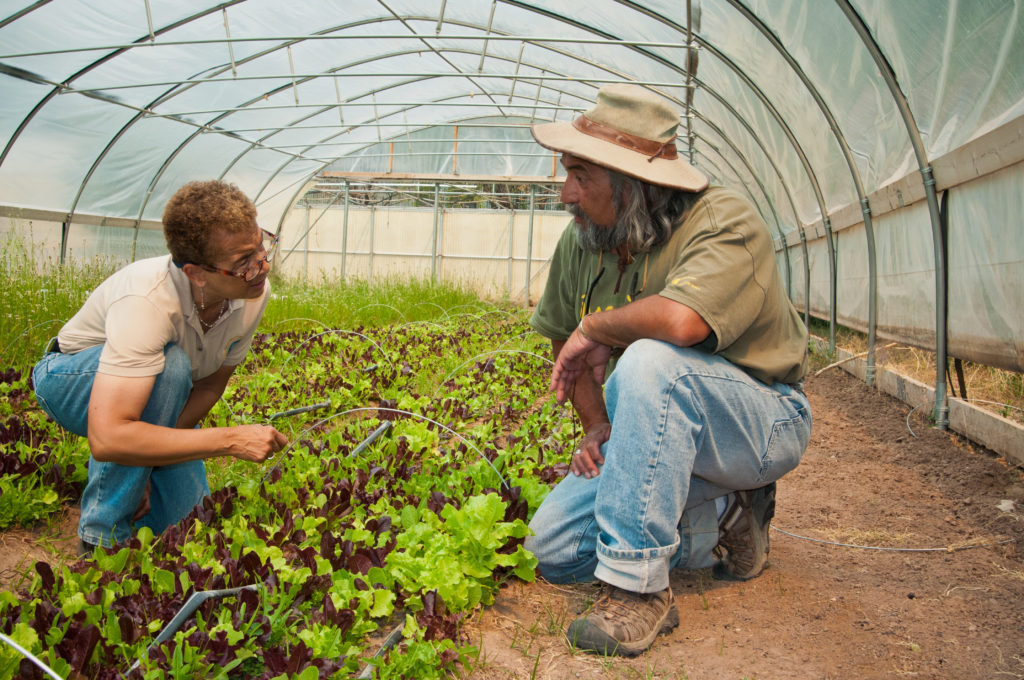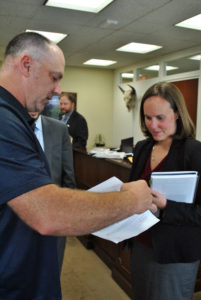
If you want to gain some real insight into agricultural policies, your first stop should be one of America’s 2.1 million farms – a majority of which are small and medium-sized family farms. Though we can’t always get Congress to the farm, we can bring the farm to Congress.
The National Sustainable Agriculture Coalition (NSAC) regularly works with our 100+ member organizations to identify farmers and ranchers who use federal sustainable agriculture programs and want to speak directly to legislators about how those programs are working. Farmer “groundtruthing” is always a key part of our work at NSAC, and one of the most important times to do that is during the appropriations season, when Congressional appropriators are deciding what programs to fund – and increasingly legislating or re-legislating through the use of amendments, or “riders”.
Recently, two such farmer advocates traveled to D.C. to meet with members of the House and Senate Appropriations Committees, and speak to them about the programs and policies that affect their daily lives. Snapshots of their experiences are profiled below, followed by an update on the annual agricultural spending bill.
Poultry Farmer Fights for Reform

On Wednesday, June 15, poultry farmer Eric Hedrick traveled from Upper Tract, West Virginia to deliver a petition signed by more than 62,000 individuals to Congress. Hedrick’s petition urged Members to allow the U.S. Department of Agriculture (USDA) to finalize common-sense rules that would protect the rights of farmers like himself, who farm livestock under contract with meat processing and packing companies.

These rules would ensure basic rights for contract farmers; rights that most of us take for granted every day like the freedom to speak out against abusive working conditions, the right to understand how your pay is calculated, or the right to a jury trial in disputes with your employer.
Hedrick has been a “contract grower” for Pilgrim’s Pride (the second largest poultry producer in the country) for 10 years; and for the last six of those years, has risked his livelihood to bring attention to the abusive practices of the contract industry.
On Hedrick’s visit to the capital he was joined by NSAC, the Rural Advancement Foundation International (RAFI)-USA (an NSAC member group), and the Government Accountability Project (GAP). His message was clear – allow USDA to move forward in finalizing these crucial rules by opposing any attempts (via policy riders) to block them in the appropriations process. While such a rider (known as the “GIPSA rider”) has already been inserted into the House Agriculture Appropriations bill by Representative Andy Harris (R-MD), there is fortunately no such rider in the pending Senate Agriculture Appropriations bill.
Kentucky Delegation Get a Taste of the “Old Homeplace”

On Thursday, June 23, Will Bowling, a livestock and crop farmer from southeastern Kentucky, met with House Appropriations Committee Chairman Hal Rogers (R-KY) and with staff for Senate Majority Leader Mitch McConnell’s (R-KY) office to talk about the USDA programs that he and his family rely upon. These programs included: the Conservation Stewardship Program (CSP), Environmental Quality Incentives Program (EQIP), and the Sustainable Agriculture Research and Education (SARE) program.
Bowling’s farm (“The Old Homeplace”) has been in his family since the mid-19th century, when his great-great grandfather, Squire Hensley, settled the land. Today, Bowling and his family farm 175 acres of that original land, and utilize several USDA programs to keep their operation economically and environmentally sustainable.

The Bowlings use both CSP and EQIP to manage and enhance their rotational grazing system, improve the quality of their soil, and keep sediment and nutrients out of local waterways. They also use the SARE program, which helps them to test and demonstrate conservation tillage techniques for small-scale specialty crop production. Bowling also spoke with his legislators about the concerning lack of training and technical assistance available to small farmers to help them comply with the Food and Drug Administration’s (FDA) new and far-reaching food safety regulations. He encouraged his legislators to support additional funding for the Food Safety Outreach Program (FSOP), which would provide this much-needed training assistance to farmers.
The Clock is Ticking
Both the House and Senate Appropriations Committees have passed their respective agriculture appropriations bills for fiscal year (FY) 2017. However, neither bill has yet to see floor time. See our earlier blogs for a full and detailed breakdown of the House and Senate bills.
It is not clear yet that either bill will get floor time before July 15, when Congress leaves town until after Labor Day. Given this upcoming extended summer break, the window for action will be the week after the July 4 holiday – during which time the Senate is expected to vote on GMO labeling legislation and funding to fight the Zika virus. According to Senate Majority Leader McConnell, the next appropriations bill to be considered on the Senate floor will be the defense funding bill. Needless to say, the short work period between July 4 and July 15 (just eight legislative days) will be very busy.
The most likely pathway for the agriculture appropriations bill to see floor time in the Senate is for it to hitch a ride on the defense appropriations bill, as part of a small package of funding bills. If this happens, the package may be considered under a modified open rule, meaning that a limited number of amendments would be offered, likely including some that are controversial. There is currently no plan that has been talked about publicly to bring the House bill to the floor, though it may still be an outside possibility.
The alternative, and more likely outcome, is that neither the House nor the Senate agriculture funding bills will go to the floor, but will rather be negotiated behind closed doors based on the committee-passed bills and included in a larger appropriations package (known as an “omnibus”) later in the year. This would likely happen in late November and December, during the post-election day “lame duck” session of Congress. Under the latter scenario, Congress would need to pass a short-term extension of last year’s funding package, prior to October 1, in order to keep the government from shutting down at the start of the new fiscal year.
Under any of these potential scenarios, we are hopeful that our key priorities, like beating back the GIPSA rider and attempts to re-open the 2014 Farm Bill to cut conservation program spending while improving funding for discretionary programs like SARE and FSOP, will be part of the final package.
For a breakdown of the current state of play for agriculture and food programs, download our appropriations chart.


Great article! Thank you for sharing real life examples of how US policy is shaping both our food system and quality of life for American farmers. The combination of what may feel like appropriations jargon paired with personal stories about farmer activists makes this issue exciting and approachable for the general public!
I just wanted to make a note that in the first paragraph about Eric Hedrick, the sentence that says “rules that would _____ the rights of farmers…” is missing an important work. Quick fix. Thanks for focusing political attention to these important issues!
Thanks Tessa!